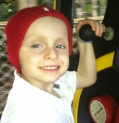Modeling GATA2 Associated MDS/AML Predisposition Syndrome Using Color-Barcoding and Mutagenesis in Zebrafish

Children and young adults with inherited mutations in the GATA2 gene have an increased risk of developing blood cancers. These cancers arise from abnormal blood stem cells. The mutant stem cell clone multiplies and expands, acquiring additional mutations that promote leukemia formation. The process is poorly understood, especially in the context of predisposition syndromes to myeloid cancers.
Project Goal: To study the steps leading to cancer formation, I generated a zebrafish model with gata2 mutation. My goal is to understand the biology of gata2 mutant stem cells during development and in young adulthood at a level of individual blood stem cells. I use a special technique of coloring blood stem cell clones, which results in groups of colored blood cells, each representing the progeny originating from a same-colored stem cell clone. In normal hematopoiesis the contribution from stem cells is balanced, resulting in multicolored blood production. However, in the presence of gata2 mutation and additional acquired mutations, a precancerous mutant clone expands and a dominant color emerges. I will test the role of specific mutations in gata2 mutant zebrafish in their ability to promote clonal dominance and eventually leukemia. I will also focus on understanding the effect of gata2 mutations on stem cells during development in zebrafish embryos, as this may be the key to explaining the risk of cancer later in life. Zebrafish is an excellent model organism for studying blood diseases, and presents a unique system to perform chemical screens with a goal of finding new therapeutic modalities for myeloid cancers.
Project Update 2022: Germline mutations in GATA2 are associated with a syndrome predisposing patients to early onset leukemias, with a median age of 19 years at diagnosis. My project aimed to model this germline condition in the zebrafish to study the pathways leading to disease onset and to identify abnormal genetic programs that can be targeted therapeutically. This award allowed me to establish the genetic model of GATA2 deficiency in the zebrafish, and validate the phenotype in this animal model, which recapitulated the blood system findings known in human patients. With the support of this award, I performed the first ever single-cell ATAC sequencing in the blood system of a germline mutant, which is a technique that looks at the state of chromatin to study changes that are caused by the germline mutation and how that changes gene expression. I discovered that GATA2 mutant zebrafish have significantly altered chromatin states that reduces their ability to produce myeloid cells and locks the myeloid development in early stages, leading to the expansion of progenitor cells which are typically the cells that transform into malignancy at the time of disease. In addition to understanding the baseline state of the chromatin and gene expression in the GATA2 mutant zebrafish, I use a unique approach in this animal model to introduce mutations in genes found in human GATA2 deficiency leukemia to study their effects and their ability to lead to disease. The technique is termed TWISTR, which combined two simple approaches - one is CRISPR mutagenesis that introduces mutations in the blood system in a way that will results in some but not all cells being mutant for the gene, a scenario that is similar to the human cancer formation that start with a single mutant cell, and second is a technique to color the blood stem cell with different fluorescent colors that way we can see the outgrowth of the mutant clone with its expansion compared to others. This way a control zebrafish blood that has no mutations appears multicolored and well-balanced as we would expect, but a mutant blood system that has a clonal outgrowth will have a large single color dominant output in the blood. I used TWISTR in the zebrafish GATA2 mutants to show that introducing mutations in a gene call ASXL1, often found in human GATA2 myeloid leukemia, results in a clonal outgrowth and negatively affects the blood production in the mutants but not the wildtype zebrafish. With this established model system, I can now test mutant leukemia clone specific genetic changes that are not present in other clones and elucidate pathways that are uniquely altered in these mutant clones to target them for therapeutic opportunities.

